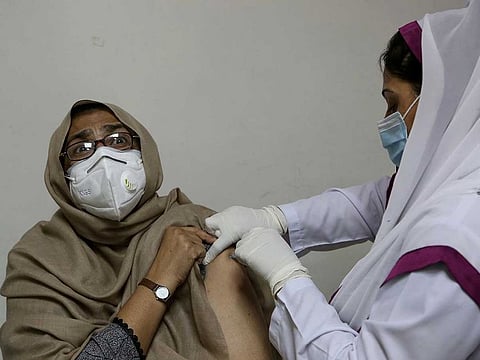COVID-19: Pakistan scrambles to arrange medical oxygen
Wary of massive coronavirus crisis in neighbouring India, Islamabad lays in provisions

When Pakistani governments impose taxes that hurt the public, a popular cry of desperation and derision inevitably greets them: one day they will also make us pay for oxygen.
The rhetorical slur has now come true. The public is paying for oxygen through its nose but not because it is taxed but because it is on short supply as Covid infections rise, breaking all previous records in Pakistan.
The situation is not touching desperate levels but it is going in that direction. Ministers are trying to be useful preaching calm to an anxious public that is exposed to the dire times that neighbouring India is witnessing and which are beamed into homes through the international media.
Measures against pandemic
“We have not run out of supplies and there is enough capacity to meet the current needs”, said a member of the National Command Center that is directing all measures against the pandemic.
“We used to expend almost 80 per cent of our oxygen in the industry and only 20 per cent was meant for the health sector, out of which nearly half was supplied through the formal sector, whereas the rest was managed by the informal sector. But now the equation is 80 for health; 20 for the industry,” he said in a telephonic interview.
This sounds reassuring — for now that is. The future does not proffer a soothing scenario. The newly-appointed information minister, Fawad Chaudhary, last week said that the country had already used up 90 per cent of its oxygen reserves attending hospital emergencies.
He then prayed to Almighty for mercy. This not fearmongering. The relatively manageable demand on the limited production capacity is based on the current figures of consumption. Considering the rising tide of Corona patients, this demand will increase manifold.
At par with spiralling demand
Some experts suggest that even then oxygen production can stay roughly at par with the spiralling demand. One expert cited by the local media said: “We estimate the average annual demand for medical oxygen to be around 100-110 tonnes per day (tpd) in Pakistan. We also estimate that Covid-19 has raised the consumption of medical oxygen, with figures varying from 300 to 500 tonnes per day in 2020.”
”We expect high demand for medical oxygen to continue throughout this year and next, with levels of 300-400 tonnes per day in 2021 and about 200-250 tonnes per day in 2022.”
“100 tpd of medical oxygen in a “peacetime” is a very low volume for 220 million population country. To compare, Vietnam having 62 million population had (by our estimations) about 250 tpd of medical oxygen available in hospitals before Covid-19. This is due to higher number of hospital beds.”
”Additional demand could vary from 300 and up to 500 tpd of medical oxygen. This quantity does not seem to be difficult to produce, release, or import. More likely, the problem is in the oxygen delivery system to the hospitals.”
This hits the nail on the head. The finer side of the problem at present relates to transportation of oxygen to the hospitals. It requires expensive vehicles designed to move the precious commodity in liquid form to the bigger hospitals which then have the wherewithal to turn into gas and administer is to the patients.
Less equipped hospitals are reliant on transportation of this life saver in gaseous form by simply getting cylinders filled and refilled and brought back to the emergency rooms.
Oxygen - a commodity in demand
The public on their own also attempt to buy oxygen as attendants are being turned back by hospitals because they may not have beds available any more.
Home-management of patients, once a preferred recommendation of the government to the people, however has run out of steam as well because individuals are the end of this oxygen supply chain and are not entertained. The prices of oxygen have also quadrupled. For some, tragedy is always profitable.
There are demands that the oxygen plant of Pakistan’s Steel Mill, long shut and awaiting privatisation, should be revived and that can meet the need of the health sector. But as a doctor who is running a 100-bed hospital in Lahore explained: “People have no idea what it takes to supply high-pressured oxygen to patients whose lungs are packing up. I have seven beds occupied in the intensive care unit and on each bed a patient is administered 50 litres oxygen per minute. The room is like a pressure cooker. Not many private hospitals even have this arrangement.”
He then added an even more significant point: “Just because you are being provided oxygen in an ICU does not mean that you have the right quantum passing through the pipes. Most hospitals don’t even provide more than 15 litres to patients in need of much more. That’s why we have one of the world’s highest mortality rates on ventilators”, he grimly added.
That gives context to the issues centred on oxygen in Pakistan. Even if the supplies are adequate, their transportation, use, administration and the attendant costs will make this one of the most important challenges for the government. Who would have thought that an elixir of life, available everywhere, could become this scarce, choking the ill, or worse, threaten to kill them. But the unthinkable is happening.
Syed Talat Hussain is a prominent Pakistani journalist and writer. Twitter: @TalatHussain12
Sign up for the Daily Briefing
Get the latest news and updates straight to your inbox








